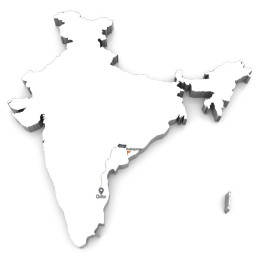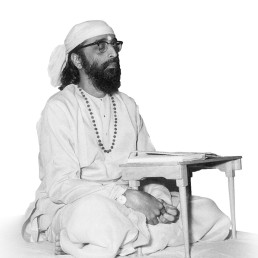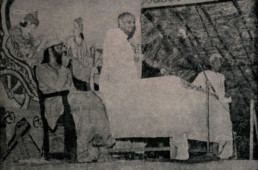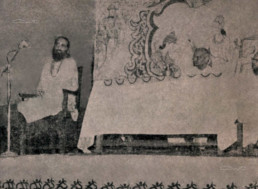
Jnana Yajna 105

Year & Dates:
June 25, 1962 to July 11, 1962

Yajna Topic:
Shrimad Bhagavad Gita- Chapter 3 & Atmabodh

Place:
Vishakhapatanam, India
A city with panoramic beaches, vibrant culture, and the oldest shipyard in India, Visakhapatnam gained the distinction of being the 105th milestone in the journey of the first 108 Jnana Yajnas performed by Pujya Gurudev.
Arriving there by the Calcutta Mail train after a brief stopover in Chennai, Pujya Gurudev was welcomed profusely both in Telugu and Sanskrit by the Visakhapatnam Gita Jnana Yajna Committee. Sri A. Suryanarayana Rao, the secretary of the yajna committee had the privilege of unfurling the OM flag, and Dr. Swami Jnanananda. Professor of Nuclear Physics, Andhra University, felt honored to inaugurate the 105th Jnana Yajna, especially in his hometown for the first time.
Pujya Gurudev started with the importance of living a spiritual life: “We know the laws of electrical energy. By mere knowledge of it, we cannot gain comforts out of it. We must implicitly obey the law, and make use of it. So it is with the Science of life, the philosophy. Mere knowing the laws of life is not enough; obeying it is unavoidable.”
Right Contact through the Highest Source
The 105th Jnana Yajna was a veritable treat with two brilliant expositions of Vedantic philosophy – Bhagavad Gita’s crowning Chapter 3, and Atmabodh, an introductory text of Vedanta – ‘a poetic garland’ of thoughtful similes, penned by Sri Adi Shankaracharya.
Pujya Gurudev highlighted the great contribution of the incomparable Veda Vyasa who revived the vanishing treasures of the Vedas at a crucial time and presented the Truth in various formats from the compiled Vedas to Puranas and also the itihasa of the voluminous Mahabharata. He spoke about the immortal role of Shrimad Bhagavad Gita which shines in Vyasa’s Mahabharata:
“In the Gita, we find how the great ideas and ideals discussed in the Upanishads can be practically applied in daily life. This textbook interprets the idealism of the Upanishads as a practical philosophy. It clearly shows the way to clear the jungle of our existence for the garden of peace and tranquility to be built up. It stands between the idealism of the Upanishads, discovered by the scientists of life, the Rishis, and our everyday life in the marketplace, factories and offices where we are forced to grapple with problems.
Gita seems to be an ‘Exchange House’ wherein we find Krishna, the great teacher, bridging, in a beautiful way, the two extremes and giving out to us the technique of the correct way of contacting the world.”
Pujya Gurudev urged the audience to imbibe and implement the techniques advised in the Gita. He also reinforced, through the verses of Atmabodh, the glory of Knowledge concluding, “Whether the sea is stormy or calm, the Sun always shines on it. Similarly the Pure Atman, the Truth which is behind time, space and causality, which is All-pervading, which has no duality, which is the Pure Consciousness in all awareness, which is the substratum on which all this pluralistic things play about, that is the One Consciousness which illumines the entire creation. Without It, nothing will exist anywhere. Know that to be your own Self.”
A Meditation Minute:
ये गुणाः सर्वशास्त्रेषु वर्ण्यन्ते ब्रह्मज्ञानिनाम् । तैरयं सर्वदा पूर्णो राजते सर्वयोगिनाम् ॥८॥
ye guṇāḥ sarvaśāstreṣu varṇyante brahmajñāninām । tairayaṃ sarvadā pūrṇo rājate sarvayoginām ॥8॥
- fully endowed with the virtues of knowers of Brahman as described in all scriptures, he ever shines among all yogis.
We stand illumined by the virtuous brilliance of our Pujya Gurudev who was a Srotriya – well-versed in all scriptures, and Brahmanishta – ever established in the Absolute Truth. In every yajna, He appealed to the people to live by what the scriptures taught, to convert learned values into lived virtues. That was the bedrock He envisioned for Chinmaya Mission.
Photo Gallery
The General Secretary, Mr., Suryanarayan Rao, whose enthusiasm and tireless effort brought Gurudev to Vishakhapatnam for this Jnana Yagna!
A Suryanarayan Rao, "Salt King" Waltair, General Secretary, addressing the Crowd nut for his enthusiasm and sacrifice 105th Yajna would not have taken place in Vishakhapatnam

“Think,” Says Pujya Gurudev
The very word Yoga, which perhaps frightened away the ordinary man by the time of the Puranic Age, is used here so liberally that we have got in the Geeta something like eight or ten different types of Yogas advised: Bhakti Yoga, Buddhi Yoga, Anasakti Yoga etc., besides Karma Yoga and Jnana Yoga. And even Yoga has been described as ‘dexterity in action’. This is, as it should be, because at certain periods of history a generation comes to entertain a sentimental dread along with an intellectual aversion for the best in their own culture and, at all such moments, a revival can take place only when this idle fear has been removed from the mind of the populace. And the easiest method of its removal is by bringing down the awe-inspiring words to cheaper usages without spoiling the glow and fire of its pristine usage.
A child, who is frightened of the domesticated cat soon grows to be a young cat-tyrant in the house, when the child slowly gets familiarized with the animal. Similarly, the Vedic technique of self perfection, which had become empty and hollow and even frightening to the Hindus of that period, through the Bhagawad Geeta, Vyasa familiarized them with the tamer implication of the terms.
From Tyagi Magazine
Because they lack in their powers of right discrimination, the qualities of the body-mind-intellect, the limitations of the physical and subtle body are super imposed by the ignorant on the Pure Self. Thereafter the deluded mistake this Real Self to be One processing all the imperfections of the superimposed equipment. This non-discrimination (Aviveka) is like the misconception which makes children believe that the sky is blue when actually it has no color.
Not only the blueness but the concavity of the sky, murkiness, misty looks, dusty conditions, are all often considered as conditions of the sky. In fact, space appears as having these qualities but space as such has none of them.
An object is not affected by the traits superimposed upon it, and here, when we superimpose certain characteristics of the body and mind on the Self-effulgent Being, the Truth itself is not affected by such misconceived notions and attributes.
From Atmabodh Book
Cause of our Suffering!
Pujya Gurudev Swami Chinmayananda elucidates how the Supreme expresses as perceiver, feeler, and thinker through the sense organs, mind, and intellect respectively. He compares the diversity of human bodies to the varied structures built from the same five elements, highlighting how individual experiences of joy and sorrow are shaped by past actions, reflected in the blueprint of one’s body.


